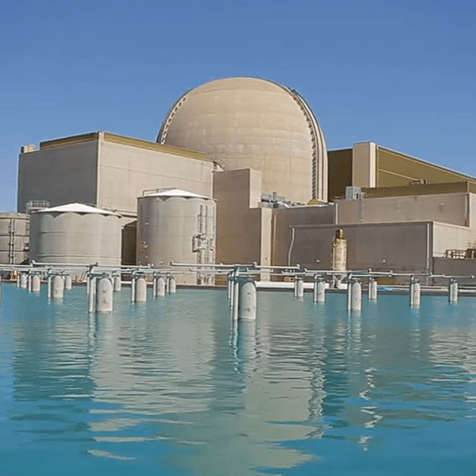 The Palo Verde Generating Station in Tonopah, Arizona (Source: U.S. Department of Energy).
The Palo Verde Generating Station in Tonopah, Arizona (Source: U.S. Department of Energy).
The U.S. Department of Energy (DOE) is partnering with utilities on four hydrogen demonstration projects at U.S. nuclear power plants.
Hydrogen would be produced at the nuclear plants through high- or low-temperature electrolysis, a process of splitting water into pure hydrogen and oxygen. High-temperature electrolyzers use both heat and electricity to split water and are more efficient.
Many believe nuclear is a tool to produce clean hydrogen, which is seen as an important path to drive decarbonization – including in hard-to-abate sectors. In power generation, hydrogen is one of the leading options for storing renewable energy and can be used in gas turbines to increase power system flexibility.
Listed below are the four nuclear plants expected to ramp up hydrogen production.
Nine Mile Point Nuclear Power Station (Oswego, NY)
DOE is supporting the construction and installation of a low-temperature electrolysis system at the Nine Mile Point station in Oswego, New York. Nine Mile Point would be the first nuclear-powered clean hydrogen production facility in the U.S. and would also use the hydrogen to help cool the plant.
Constellation plans to begin producing hydrogen there before the end of 2022.
The utility also partnered with NYSERDA on a separate project to power a fuel cell at the facility and will start providing additional power to the grid in 2025.
Davis–Besse Nuclear Power Station (Oak Harbor, OH)
Energy Harbor is working to demonstrate a low-temperature electrolysis system at the Davis–Besse Nuclear Power Station. The single unit reactor is expected to produce clean hydrogen by 2023.
Energy Harbor is part of a larger group called the Great Lakes Clean Hydrogen (GLCH) coalition. GLCH aims to develop a Midwestern regional hydrogen hub and is applying for DOE funding
Hydrogen produced at Davis-Besse could support local manufacturing and transportation services, including fuel for a local bus fleet.
Prairie Island Nuclear Generating Plant (Red Wing, MN)
Xcel Energy is working on a demonstration project coupling Bloom Energy’s high-temperature electrolysis with the Prairie Island nuclear plant in Red Wing, Minnesota.
Engineering for the Xcel-Bloom 240 KW demonstration is currently underway, with construction expected to begin in late 2023 and power-on expected in early 2024.
Palo Verde Generating Station (Tonopah, AZ)
Finally, DOE is negotiating an award with Arizona Public Service (APS) and PNW Hydrogen to demonstrate another low-temperature electrolysis system at the Palo Verde Generating Station in Tonopah, Arizona.
The hydrogen would be used to produce electricity during times of high demand or to make chemicals and other fuels. The project could start producing hydrogen in 2024.
According to the DOE, a single 1,000 MW nuclear reactor could produce more than 150,000 metric tons of hydrogen each year. Ten nuclear reactors could provide about 1.5 million metric tons annually or 15% of current hydrogen produced in the United States, the DOE said.
